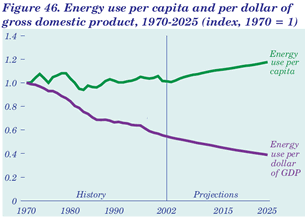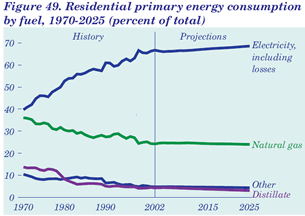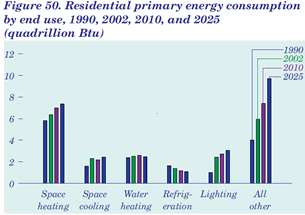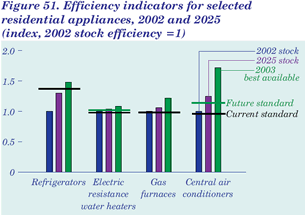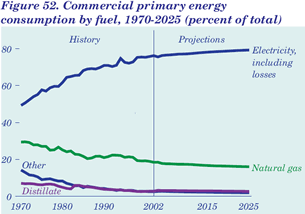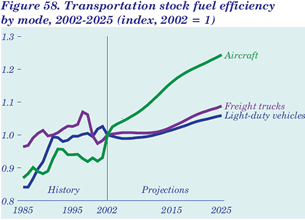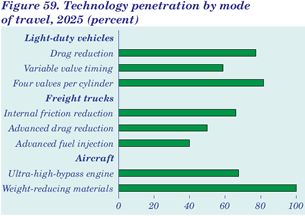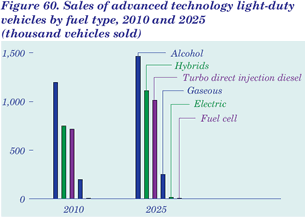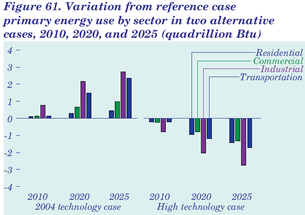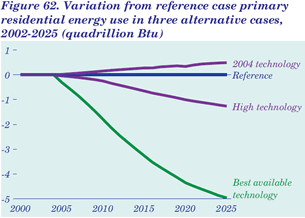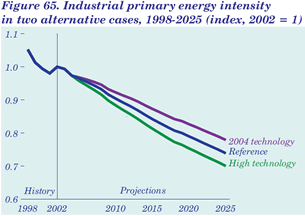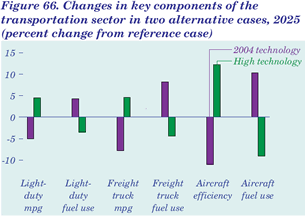|
Annual Energy Outlook 2004 with Projections to 2025 Market Trends - Energy Demand Index (click to jump links) Annual Growth in Energy Use Is Projected To Continue Net energy delivered to consumers represents only a part of total primary energy consumption. Primary consumption includes energy losses associated with the generation, transmission, and distribution of electricity, which are allocated to the end-use sectors (residential, commercial, and industrial) in proportion to each sector’s share of electricity use [103].
How energy consumption is measured has become more important over time, as reliance on electricity has expanded. In 1970, electricity accounted for only 12 percent of energy delivered to the end-use sectors, excluding transportation. Since then, the growth in electricity use for applications such as space conditioning, consumer appliances, telecommunication equipment, industrial machinery, and office equipment has resulted in greater divergence between primary and delivered energy consumption (Figure 45). This trend is expected to stabilize in the forecast, as more efficient generating technologies offset increased demand for electricity. Both projected primary energy consumption and delivered energy consumption grow by 1.3 percent per year, excluding transportation use. At the end-use sectoral level, tracking of primary energy consumption is necessary to link specific policies with overall goals. Carbon dioxide emissions, for example, are closely correlated with primary energy consumption. In the development of carbon dioxide stabilization policies, growth rates for primary energy consumption are generally more important than those for delivered energy. Average Energy Use per Person Increases in the Forecast Energy intensity, as measured by energy use per dollar of GDP, is projected to decline at an average annual rate of 1.5 percent, with efficiency gains and structural shifts in the economy offsetting growth in demand for energy services (Figure 46). This rate of improvement is generally consistent with recent historical experience. With energy prices increasing between 1970 and 1986, energy intensity declined at an average annual rate of 2.3 percent, as the economy shifted to less energy-intensive industries, product mix changed, and more efficient technologies were adopted. Between 1986 and 1992, however, when energy prices were generally falling, energy intensity declined at an average rate of only 0.7 percent per year. Since 1992, it has declined on average by 1.9 percent per year. Energy use per person generally declined from 1970 through the mid-1980s but began to increase as energy prices declined in the late 1980s and the 1990s. Per capita energy use is projected to increase in the AEO2004 forecast, and the projected demand for energy services in 2025 is markedly higher than in 2002. The average home in 2025 is expected to be 6 percent larger (1,788 square feet in 2025 versus 1,689 square feet in 2002) and to use electricity more intensively. Personal highway travel and air travel per capita are expected to average 2.2 percent and 2.3 percent growth per year, respectively, from 2002 to 2025. The growth in demand for energy services is only partially offset by efficiency gains in the projections, and as a result primary energy use per capita is projected to increase by 0.7 percent per year through 2025. Petroleum and Electricity Lead Growth in Energy Consumption Consumption of petroleum products, mainly for transportation, makes up the largest share of primary energy use in the AEO2004 forecast (Figure 47). Growth in energy demand for transportation averaged 2.0 percent per year in the 1970s but was slowed in the 1980s by rising fuel prices and new Federal efficiency standards that led to a 2.1-percent annual increase in average vehicle fuel economy. Fuel economy gains are projected to slow as a result of stable fuel prices and the absence of new standards. Growth in population and travel per capita is expected to increase demand for gasoline over the forecast.
Through 2007, increased competition, cost reductions from technological advances, and excess generating capacity from the recent boom in construction are projected to reduce average electricity prices. Price increases are expected after 2008, as higher coal and natural gas prices raise generation costs. Growth in electricity use is expected to be slowed by efficiency improvements and by market saturation of end uses such as air conditioning in some regional markets. End-use demand for natural gas is projected to grow at a slightly slower rate than overall end-use energy demand, in contrast to the recent trend of more rapid growth in the use of gas as the industry was deregulated. Natural gas is projected to meet 24 percent of end-use energy requirements in 2025. End-use demand for energy from renewables such as wood and ethanol is projected to increase by 1.9 percent per year. Geothermal and solar energy use in buildings is expected to increase by about 2.4 percent per year but to provide less than 1 percent of the energy used for space and water heating. U.S. Primary Energy Use Exceeds 136 Quadrillion Btu per Year by 2025 Primary energy use in the reference case is projected to reach 136.5 quadrillion Btu by 2025, 40 percent higher than the 2002 level. In the early 1980s, as energy prices rose, sectoral energy consumption grew relatively little (Figure 48). Between 1980 and 2002, however, declining real energy prices contributed to a marked increase in energy consumption. With higher energy prices since the late 1990s, energy consumption has again slowed. In the forecast, energy demand in the residential sector is projected to grow at one-third the expected growth rate for GDP and in the commercial sector at just over one-half the GDP growth rate. Demand for energy is expected to grow more rapidly in the transportation sector than in the buildings sectors as a result of increased per capita travel and slower fuel efficiency gains. Assumed efficiency gains, higher real energy prices, and structural shifts between industries are projected to cause industrial demand for primary energy to grow more slowly than GDP. To bracket the uncertainty inherent in any long-term forecast, alternative cases were used to highlight the sensitivity of the forecast to different oil price and economic growth paths. At the consumer level, oil prices primarily affect the demand for transportation fuels. Projected oil use for transportation in the high world oil price case is 13.2 percent lower than in the low world oil price case in 2025, as consumer choices favor more fuel-efficient vehicles and the demand for travel services is reduced slightly. For 2025, the projection of total annual energy use in the high economic growth case is 15.4 percent greater than in the low economic growth case. Residential Sector Energy Demand Energy Fuel Shares for Residential Use Are Expected To Remain Stable Residential energy use is projected to increase by 25 percent between 2002 and 2025 (10 percent by 2010). Most (76 percent) of the projected growth is related to increased use of electricity. Sustained growth in housing in the South, where almost all new homes use central air conditioning, is an important component of the national trend, along with the penetration of consumer electronics, such as home office equipment and security systems (Figure 49).
Natural gas use in the residential sector is projected to grow by 1.5 percent per year from 2002 to 2010 and 0.9 percent per year to 2025, maintaining a constant share of total residential primary energy consumption. Natural gas prices to residential customers are projected to increase by 9 percent from 2002 to 2025, remaining competitive with heating oil. The number of homes heated with natural gas is projected to increase by more than the number heated with electricity or oil. Distillate use is projected to fall by 10 percent between 2002 and 2025, as energy efficiency gains outpace the increase in the number of homes using home heating oil for space heating applications. Newly built homes today are, on average, 26 percent larger than the existing housing stock, with correspondingly greater needs for heating, cooling, and lighting. Under current building codes and appliance standards, however, energy use per square foot is typically lower for new construction than for the existing stock. Further reductions in residential energy use per square foot could result from additional gains in equipment efficiency and more stringent building codes, requiring more insulation, better windows, and more efficient building designs. Efficiency Standards Moderate Residential Energy Use Energy use for space heating, the most energy-intensive end use in the residential sector, grew by 0.7 percent per year from 1990 to 2002 (Figure 50). Future growth is expected to be slowed by higher equipment efficiency and more stringent building codes. Gains in building shell efficiency are projected to reduce demand for space heating per household by about 4 percent in 2010 and 9 percent in 2025 relative to 2002. A variety of appliances are now subject to minimum efficiency standards, including heat pumps, air conditioners, furnaces, refrigerators, and water heaters. Current (July 2001) standards for a typical residential refrigerator limit electricity use to 478 kilowatthours per year. Energy use for refrigeration is projected to decline by 2.0 percent per year from 2002 to 2010 and 0.9 percent per year to 2025 as older refrigerators are replaced with new models. With no new standards for refrigerators assumed in the forecast, the decline slows when large numbers of the older, less efficient units have been replaced. The “all other” category (including small appliances such as personal computers, dishwashers, clothes washers, and dryers), which grew by 3.3 percent per year from 1990 to 2002 and accounted for 29 percent of residential primary energy use in 2002, is projected to account for 37 percent in 2025. Voluntary standards, both within and outside the appliance industry, are expected to forestall even larger increases. Even so, the “all other” category is projected to exceed other components of residential demand by 2025, growing at annual rates of 2.8 percent from 2002 to 2010 and 2.1 percent from 2002 to 2025. Available Technologies Can Slow Growth in Residential Energy Use The AEO2004 reference case projects an increase in the stock efficiency of residential appliances, as stock turnover and technology advances in most end-use services reduce residential energy intensity over time. For most appliances covered by the National Appliance Energy Conservation Act of 1987, the most recent Federal efficiency standards are higher than the 2002 stock, ensuring an increase in stock efficiency (Figure 51) without any additional new standards. Future updates to the Federal standards could have a significant effect on residential energy consumption, but they are not included in the reference case. The new efficiency standards for water heaters, clothes washers, central air conditioners, and heat pumps that were announced in January 2001 are included in the reference case.
For almost all end-use services, existing technologies can significantly curtail future energy demand if they are purchased by consumers. The most efficient technologies can provide significant long-run savings in energy bills, but their higher purchase costs tend to restrict their market penetration. For example, condensing technology for natural gas furnaces, which reclaims heat from exhaust gases, can raise efficiency by more than 20 percent over the current standard; and variable-speed scroll compressors for air conditioners and refrigerators can increase their efficiency by 50 percent or more. In contrast, there is little room for efficiency improvements in electric resistance water heaters, because the technology is approaching its thermal limit. Commercial Sector Energy Demand Electricity Share of Commercial Energy Use Is Expected To Increase Projected energy use trends in the commercial sector show stable shares for all fuels, with growth in overall consumption slowing from its pace over the past three decades (Figure 52). Commercial energy use, including electricity-related losses, is projected to grow by 1.7 percent per year between 2002 and 2025, slightly faster than the projected growth rate for commercial floorspace of 1.5 percent. Energy consumption per square foot is projected to show little increase, with efficiency standards, voluntary government programs aimed at improving efficiency, and other technology improvements expected to balance the effects of a projected increase in demand for electricity-based services and generally stable or declining fuel prices. Electricity accounted for 76 percent of commercial primary energy consumption in 2002, and its share is projected to increase to 79 percent in 2025. Expected efficiency gains in electric equipment are projected to be offset by the continuing penetration of new technologies and greater use of office equipment. Natural gas, which accounted for 18 percent of commercial energy consumption in 2002, is projected to decline to a 16-percent share by the end of the forecast. Distillate fuel oil made up only 3 percent of commercial demand in 2002, down from 6 percent in the years before deregulation of the natural gas industry. The fuel share projected for distillate remains at 3 percent in 2025, as fuel oil continues to compete with natural gas for space and water heating uses. With stable prices projected for conventional fuels, no appreciable growth in the share of renewable energy in the commercial sector is anticipated. Lighting Is the Commercial Sector’s Most Important Energy Application Through 2025, lighting is projected to remain the most important individual end use in the commercial sector [104]. Energy use for lighting is projected to increase slightly, as growth in lighting requirements outpaces adoption of more energy-efficient lighting equipment. Efficiency of space heating, space cooling, and water heating is also expected to improve, moderating growth in overall commercial energy demand. A projected increase in building shell efficiency, which affects the energy required for space heating and cooling, contributes to the trend (Figure 53).
The highest growth rates are expected for end uses that have not yet saturated the commercial market. Energy use for personal computers is projected to grow by 4.1 percent per year and for other office equipment, such as copiers, fax machines, and larger computers, by 4.3 percent per year through 2025. The projected growth in electricity use for office equipment reflects a trend toward more powerful equipment, increases in the market for commercial electronic equipment, and, while electricity prices fluctuate somewhat (declining in the early years and increasing later), generally low real electricity prices. Natural gas use for such miscellaneous uses as cooking and self-generated electricity is expected to grow by 1.3 percent per year. New telecommunications technologies and medical imaging equipment are projected to increase electricity demand in the “all other” end-use category, which also includes ventilation, refrigeration, minor fuel consumption, and energy use for a myriad of other uses, such as municipal water services, service station equipment, and vending machines. Annual growth of 2.3 percent is expected for the “all other” category. Industrial Sector Energy Demand Industrial Energy Use Could Grow by 33 Percent by 2025 From 1970 to 1986, with demand for coking coal reduced by declines in steel production and with natural gas use falling as a result of end-use restrictions and curtailments, electricity’s share of industrial energy use increased from 23 percent to 33 percent. The natural gas share fell from 32 percent to 24 percent, and coal’s share fell from 16 percent to 9 percent. After 1986, natural gas began to recover its share as end-use regulations were lifted and supplies became more certain and less costly. As on-site cogeneration increased, the share of industrial delivered energy use made up by purchased electricity leveled off. Primary energy use in the industrial sector—which includes the agriculture, mining, and construction industries in addition to traditional manufacturing—is projected to increase by 1.2 percent per year (Figure 54). Electricity (for machine drive and some production processes) and natural gas (given its ease of handling) are the major energy sources for heat and power in the industrial sector. Industrial purchased electricity use is projected to increase by 43 percent from 2002 to 2025, with competition in the generation market keeping electricity prices low. Despite a projected increase in natural gas prices after 2002, its use for energy in the industrial sector is expected to increase by 15 percent from 2002 to 2010 and by 41 percent from 2002 to 2025. Petroleum use for energy in the industrial sector is projected to grow by 19 percent from 2002 to 2025. Coal use is expected to decline by 3 percent from 2002 to 2010 and by 8 percent from 2002 to 2025, as new steelmaking technologies continue to reduce demand for metallurgical coal. Coal use for boiler fuel and as a substitute for coke in steelmaking remains essentially flat. Industrial Energy Use Grows Steadily in the Projections About 70 percent of the energy consumed in the industrial sector is used to provide heat and power for manufacturing. The remainder is approximately equally distributed between nonmanufacturing heat and power uses and nonfuel uses, such as raw materials and asphalt (Figure 55). Nonfuel use of energy (feedstocks and asphalt) in the industrial sector is projected to grow at the same rate as heat and power consumption (1.2 percent per year). The feedstock portion of nonfuel use is projected to grow by 1.2 percent per year, slower than the growth in output in the bulk chemical industry (1.6 percent through 2025), because of changes in the product mix. In 2025, feedstock consumption is projected to be 4.9 quadrillion Btu. Asphalt use is projected to grow by 1.3 percent per year to 1.7 quadrillion Btu in 2025. The construction industry is the principal consumer of asphalt for paving and roofing. Asphalt use does not grow as rapidly as construction output (2.2 percent per year through 2025), because not all construction activities require asphalt. Petroleum refining, chemicals, and pulp and paper are among the largest end-use consumers of energy for heat and power in the manufacturing sector. These three energy-intensive industries used 8.1 quadrillion Btu of delivered energy in 2002. The major fuels used in petroleum refineries are still gas, natural gas, and petroleum coke. In the chemical industry, natural gas accounts for approximately 55 percent of the delivered energy consumed for heat and power. The pulp and paper industry uses the most renewables, in the form of wood and spent liquor. Output From U.S. Industries Grows Faster Than Energy Use Changes in industrial energy intensity (consumption per unit of output) can be separated into two effects. One component reflects underlying increases in equipment and production efficiencies; the other arises from structural changes in the composition of industrial value of shipments. Since 1970, the use of more energy-efficient technologies, combined with relatively low growth in the energy-intensive industries, has dampened growth in industrial energy consumption. Thus, despite a 41-percent increase in industrial shipments, total energy use in the sector grew by only 1 percent between 1980 and 2002. Energy consumption is projected to grow more slowly than industrial shipments in the AEO2004 reference case.
Industrial value of shipments is projected to grow by 2.6 percent between 2002 and 2025. The share of total industrial shipments attributed to the energy-intensive industries is projected to fall from 21 percent in 2002 to 17 percent in 2025. Consequently, even if no specific industry experienced a decline in intensity, aggregate industrial energy intensity would decline. Figure 56 shows projected changes in energy intensity due to structural effects and efficiency effects separately [105]. From 2002 to 2025, industrial delivered energy intensity is projected to drop by 26 percent. The changing composition of industrial output is expected to result in a drop in energy intensity of approximately 17 percent by 2025. Thus, two-thirds of the expected change in delivered energy intensity for the sector is attributable to structural shifts and the remainder to changes in energy intensity associated with projected increases in equipment and production efficiencies. Transportation Sector Energy Demand Alternative Fuels Make Up 2.1 Percent of Light-Duty Vehicle Fuel Use in 2025 Energy demand for transportation is projected to grow from 26.8 quadrillion Btu in 2002 to 41.2 quadrillion Btu in 2025 (Figure 57). Petroleum products dominate energy use in the sector. In the reference case, motor gasoline use increases by 1.8 percent per year from 2002 to 2025, when it makes up 60 percent of transportation energy use. Alternative fuels are projected to displace 136,800 barrels of oil equivalent per day [106] in 2010 and 166,500 barrels per day (2.1 percent of light-duty vehicle fuel consumption) in 2025, in response to current environmental and energy legislation intended to reduce oil use. Gasoline’s share of demand is expected to be sustained, however, by low gasoline prices and slower fuel efficiency gains for conventional light-duty vehicles (cars, vans, pickup trucks, and sport utility vehicles) than were achieved during the 1980s. Assumed industrial output growth of 2.6 percent per year from 2002 to 2025 leads to an increase in freight transport, with a corresponding 2.3-percent annual increase in diesel fuel use. Economic growth and low projected jet fuel prices yield an annual increase in air travel of 2.3 percent from 2002 to 2025 and a 1.8-percent average annual increase in jet fuel use. In the forecast, energy prices directly affect the level of oil use through travel costs and average vehicle fuel efficiency. Most of the price sensitivity is seen as variations in motor gasoline use in light-duty vehicles, because the stock of light-duty vehicles turns over more rapidly than do the stocks for other modes of travel. In the high world oil price case, gasoline use increases by 1.2 percent per year, compared with 2.1 percent per year in the low oil price case. Average Horsepower for New Cars Is Projected To Grow by 24 Percent Fuel efficiency is projected to improve more slowly from 2002 to 2025 than it did during the 1980s. Fuel economy for the light-duty vehicle stock is projected to improve by 6 percent, and for the stock of freight trucks from 6.0 miles per gallon in 2002 to 6.5 in 2025 (Figure 58). A larger gain (22.2 percent) is expected for aircraft. Fuel economy standards for cars are assumed to stay at current levels and light truck standards increase to 22.2 miles per gallon by 2007 [107]. Projected low fuel prices and higher personal incomes are expected to increase the demand for larger, more powerful vehicles, with average horsepower for new cars projected to be 23.9 percent above the 2002 average in 2025 (Table 20). Advanced technologies and materials are expected to provide increased performance and size while improving new vehicle fuel economy [108]. Advanced technologies are projected to boost the average fuel economy of new light-duty vehicles by about 1.5 miles per gallon, to 25.3 miles per gallon, in 2010 and by about 3 miles per gallon, to 26.9 miles per gallon, in 2025. New Technologies Promise Better Vehicle Fuel Efficiency New automobile fuel economy is projected to remain relatively constant through 2010 but to increase to 30.8 miles per gallon in 2025 as a result of advances in fuel-saving technologies (Figure 59). Three of the most promising would provide more than 4 percent higher fuel economy each: advanced drag reduction, variable valve timing and lift, and technologies that reduce internal engine friction. Advanced drag reduction reduces air resistance over the vehicle; variable valve timing optimizes the timing of air intake into the cylinder with the spark ignition during combustion; and reduced engine friction increases engine efficiency through more efficient designs, bearings, and coatings that reduce resistance between moving parts. Due to concerns about economic payback, the trucking industry is more sensitive to the marginal cost of fuel-efficient technologies; however, several technologies can increase fuel economy significantly, including components to reduce internal friction (2-percent improvement), advanced drag reduction (2 percent), and advanced fuel injection systems (5 percent). These technologies are expected to penetrate the heavy-duty truck market by 2025. Advanced technology penetration is projected to increase the average fuel efficiency of new freight trucks from 6.7 miles per gallon in 2002 to 7.1 miles per gallon in 2025. New aircraft fuel efficiencies are projected to increase by 16 percent from 2002 levels by 2025. Ultra-high-bypass engine technology can potentially increase fuel efficiency by 10 percent, and increased use of weight-reducing materials may contribute up to a 15-percent improvement. Advanced Technologies Could Reach 19 Percent of Sales by 2025 Advanced technology vehicles, representing automotive technologies that use alternative fuels or require advanced engine technology, are projected to reach 3.9 million vehicle sales per year and make up 19.0 percent of total light-duty vehicle sales in 2025. Alcohol flexible-fueled vehicles are projected to continue to lead advanced technology vehicle sales, at 1.4 million vehicles in 2025 (Figure 60). Hybrid electric vehicles, introduced into the U.S. market by two manufacturers in 2000, are anticipated to sell well: 750,000 units are projected to be sold in 2010, increasing to 1.1 million units in 2025. Sales of turbo direct injection diesel vehicles are projected to increase to 716,000 units in 2010 and 1 million units in 2025. About 80 percent of advanced technology sales are as a result of Federal and State mandates for fuel economy standards, emissions programs, or other energy regulations. Currently, manufacturers selling alcohol flexible-fueled vehicles receive fuel economy credits that count toward compliance with corporate average fuel economy regulations. In the AEO2004 forecast, the majority of projected gasoline hybrid, fuel cell, and electric vehicle sales result from compliance with low-emission vehicle programs in California, New York, Maine, Vermont, and Massachusetts. Energy Demand in Alternative Technology Cases Alternative Cases Analyze Effects of Advances in Technology The availability and market penetration of new, more efficient technologies are uncertain. Alternative cases for each sector, based on a range of assumptions about technological progress, show the effects of these assumptions (Figure 61). The alternative cases assume that current equipment and building standards are met but do not include feedback effects on energy prices or on economic growth. For the residential and commercial sectors, the 2004 technology case holds equipment and building shell efficiencies at 2004 levels. The best available technology case assumes that the most energy-efficient equipment and best residential building shells available are chosen for new construction each year regardless of cost, and that the efficiencies of existing residential and all commercial building shells improve from their reference case levels. The high technology case assumes earlier availability, lower costs, and higher efficiencies for more advanced technologies than in the reference case. The 2004 technology cases for the industrial and transportation sectors and the high technology case for the industrial sector use the same assumptions as the buildings sector cases. For transportation, the high technology assumptions include lower costs and improved efficiencies for advanced light-duty vehicles and aircraft technologies and improved efficiencies for conventional light-duty vehicles, freight trucks, and air, rail, and marine travel, as reflected in several studies of potential improvement in transportation technologies [109]. Advanced Technologies Could Reduce Residential Energy Use by 19 Percent The AEO2004 reference case includes the effects of several different policies aimed at increasing residential end-use efficiency, including minimum efficiency standards and voluntary energy savings programs to promote energy efficiency through innovations in manufacturing, building, and mortgage financing. In the 2004 technology case, assuming no increase in efficiency of equipment or building shells beyond that in 2004, 2 percent more energy would be required in 2025 than in the reference case (Figure 62). In the best available technology case, assuming that the most energy-efficient technology considered is always chosen regardless of cost, projected residential primary energy use in 2025 is 19 percent lower than in the reference case and 20 percent lower than in the 2004 technology case. Through 2025, projected additional investment of $367 billion relative to that in the reference case would be necessary to save a projected $144 billion in energy costs in the best available technology case [110]. The high technology case does not constrain consumer choices. Instead, the most energy-efficient technologies are assumed to be available earlier, with lower costs and higher efficiencies. The consumer discount rates used to determine the purchased efficiency of all residential appliances in the high technology case do not vary from those used in the reference case; that is, consumers value efficiency equally across the two cases. Energy consumption in 2025 in the high technology case is projected to be 5 percent lower than in the reference case; however, the savings are not as great as those projected in the best available technology case. Advanced Technologies Could Slow Electricity Sales Growth for Buildings Alternative technology cases for the buildings sectors include a range of assumptions for the availability and market penetration of advanced distributed generation technologies (solar photovoltaic systems, fuel cells, and microturbines). Some of the heat produced by fossil-fuel-fired generating systems may be used to satisfy heating requirements, increasing system efficiency and the attractiveness of the advanced technologies, particularly in alternative cases with more optimistic technology assumptions. In the high technology case, buildings are projected to generate 8 billion kilowatthours (38 percent) more electricity in 2025 than in the reference case (Figure 63), most of which offsets residential and commercial electricity purchases. In the best available technology case, projected electricity generation in buildings in 2025 is 30 billion kilowatthours (153 percent) higher than in the reference case. In the 2004 technology case, assuming no further technological progress or cost reductions after 2004, electricity generation in buildings in 2025 is 9 billion kilowatthours (46 percent) lower than projected in the reference case. The additional natural gas use projected for fuel cells and microturbines to provide heat and power in commercial buildings in the high technology case offsets reductions from improved building shells and end-use equipment. Although the best technology case projects even higher adoption of these technologies, the additional end-use savings projected when the most efficient technologies are chosen, regardless of cost, outweigh the additional natural gas consumption needed to fuel distributed generation systems. Advanced Technologies Could Reduce Commercial Energy Use by 15 Percent The AEO2004 reference case incorporates efficiency improvements for commercial equipment and building shells, limiting commercial energy intensity (energy use per square foot of floorspace) to a 0.2-percent annual increase over the forecast. The 2004 technology case assumes that future equipment and building shells will be no more efficient than those available in 2004. The high technology case assumes earlier availability, lower costs, and higher efficiencies for more advanced equipment than in the reference case and more rapid improvement in building shells. The best available technology case assumes that only the most efficient technologies will be chosen, regardless of cost, and that building shells will improve at a faster rate than assumed in the high technology case. In the 2004 technology case, projected energy use in 2025 is 4 percent higher than the 25.9 quadrillion Btu used in the reference case (Figure 64), as a result of an 0.4-percent average annual increase in commercial primary energy intensity. The high technology case projects an additional 5-percent energy savings in 2025 relative to the reference case, with little change in primary energy intensity from 2002 to 2025. In the best available technology case, commercial primary energy intensity is projected to improve by 0.5 percent per year, and projected energy use in 2025 is 15 percent lower than in the reference case. More optimistic assumptions result in additional projected energy savings from both renewable and conventional fuel-using technologies. In 2025, commercial solar photovoltaic systems are projected to generate 86 percent more electricity in the high technology case than in the reference case. Alternative Technology Cases Show Range of Industrial Efficiency Gains Efficiency gains in both energy-intensive and non-energy-intensive industries are projected to reduce overall energy intensity in the industrial sector. Expected output growth in metal-based durables (3.8 percent per year), driven primarily by investment and export-related demand, is a key factor. In the reference case, this non-energy-intensive group of industries is projected to grow more than twice as fast as the energy-intensive sectors (1.6 percent per year). In the high technology case, 2.2 quadrillion Btu less energy is projected to be used in 2025 than for the same level of output in the reference case. Industrial primary energy intensity is projected to improve by 1.5 percent per year through 2025 in this case, compared with 1.3-percent annual improvement in the reference case (Figure 65). Industrial cogeneration capacity is projected to increase more rapidly in the high technology case (3.2 percent per year) than in the reference case (2.4 percent per year). In the 2004 technology case, industry is projected to use 2.3 quadrillion Btu more energy in 2025 than in the reference case. Energy efficiency remains at the level achieved by new equipment in 2004, but average efficiency still improves as old equipment is retired. Aggregate industrial energy intensity is projected to decline by 1.1 percent per year because of reduced efficiency gains. The change in industrial structure is the same in the 2004 technology and high technology cases as in the reference case, because the same macroeconomic assumptions are used for the three cases. Industrial cogeneration capacity is projected to increase by 2.2 percent per year from 2002 to 2025 in the 2004 technology case. Vehicle Technology Advances Reduce Transportation Energy Demand The transportation high technology case assumes lower costs and higher efficiencies for new technologies. Projected energy use for transportation is 1.7 quadrillion Btu (4.2 percent) lower in 2025 than in the reference case. In 2025, about 49 percent (0.9 quadrillion Btu) of the difference is attributed to the improved efficiency of light-duty vehicles. Advances in conventional technologies and in vehicle attributes for advanced technologies are projected to raise the average efficiency of the light-duty vehicle fleet to 21.8 miles per gallon, as compared with a projected increase to 20.9 miles per gallon in the reference case (Figure 66). Projected fuel demand for freight trucks in 2025 is 0.3 quadrillion Btu lower in the high technology case than in the reference case, and the projected stock efficiency is 4.6 percent higher. Advanced aircraft technologies are also projected to improve aircraft efficiency by 12 percent above the reference case projection, reducing the projected fuel use for air travel in 2025 by 0.5 quadrillion Btu. In the 2004 technology case, with new technology efficiencies fixed at 2004 levels, efficiency improvements can result only from stock turnover. In 2025, the total projected energy demand for transportation is 2.4 quadrillion Btu (5.8 percent) higher than in the reference case. The average fuel economy of new light-duty vehicles is projected to be 24.8 miles per gallon in 2025 in the 2004 technology case, 2.1 miles per gallon lower than projected in the reference case.
Released: January 2004 |
||||||||||||||||||||||||||||||||||||||||||||||||||||||||||||||||||||||||||||||||||||||||||||||||||||||||||||||||||||||

